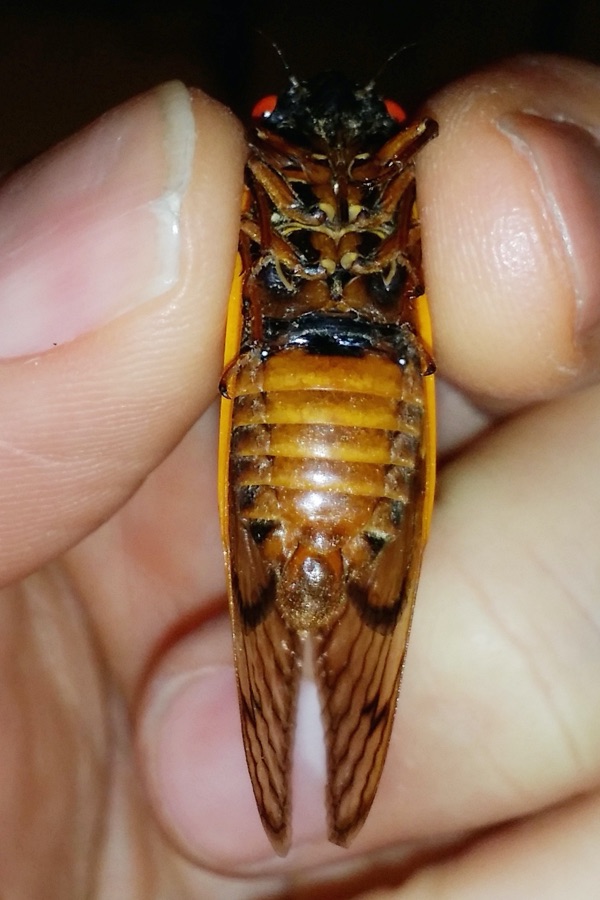Magicicada tredecim (Walsh and Riley, 1868).

Photo credit: by Dan Mozgai. Ohio.
All Magicicada tredecim information and images on cicadamania.com.
Song type: Call
Source: ©Insect Singers | Species: M. tredecim
Identification tips:
Similar to M. neotredecim, but the abdomen is typically more orange — these species overlap in limited areas, in which M. tredecim maintains the normal pitch of its call, and M. neotredecim raises its pitch. Read more on Cicadas @ UCONN (formerly Magicicada.org). Larger than M. tredecassini and M. tredecula.
Brood chart
Magicicada tredecim has a 13-year life cycle.
| Brood | Year | States |
|---|---|---|
| XIX (19) | 1972, 1985, 1998, 2011, 2024 | AL, AR, GA, IL, IN, KY, LA, MO, MS, NC, OK, SC, TN, VA |
| XXII (22) | 1975, 1988, 2001, 2014, 2027 | KY, LA, MS, OH |
| XXIII (23) | 1976, 1989, 2002, 2015, 2028 | AR, IL, IN, KY, LA, MO, MS, TN |
Name, Location and Description
- Cicada Name: Magicicada tredecim (Walsh and Riley, 1868)
- Short Name: M. tredecim
- Common Name: 13-Year Cicada or 13-Year Decim
- When: May-June. Peak in June. Every 13 years.
- Where it is found: AL, AR, GA, IL, IN, KY, LA, MD, MO, MS, NC, OH, OK, SC, TN, VA
- Maps: Map
- Description: Black body with orange wings and legs. Orange stripes on abdomen. Orange between eye and wing.
- Eye Color: reddish orange
- Pronotal Collar Color: black
- Identification: Bug Guide
- Subject Matter Expert website: Cicadas @ UCONN (formerly Magicicada.org)
- Taxonomic Information: Integrated Taxonomic Information System
- Song: Cicadas @ UCONN (formerly Magicicada.org)
Classification:
Family: Cicadidae
Subfamily: Cicadettinae
Tribe: Lamotialnini
Subtribe: Tryellina
Genus: Magicicada
Species: Magicicada tredecim (Walsh and Riley, 1868)
List of sources
- Full Binomial Names: ITIS.gov
- Common names: BugGuide.net; The Songs of Insects by Lang Elliott and Wil Herschberger; personal memory.
- Locations: Cicadas @ UCONN (formerly Magicicada.org)
- Descriptions, Colors: personal observations from specimens or photos from many sources. Descriptions are not perfect, but may be helpful.
- Tribe information comes from: MARSHALL, DAVID C. et al.A molecular phylogeny of the cicadas (Hemiptera: Cicadidae) with a review of tribe and subfamily classification.Zootaxa, [S.l.], v. 4424, n. 1, p. 1—64, may 2018. ISSN 1175-5334. Available at: https://www.biotaxa.org/Zootaxa/article/view/zootaxa.4424.1.1
Notes:
- Some descriptions are based on aged specimens which have lost some or a lot of their color.

Please tell me…can they colonize around/under dump houses? I’m asking out of concern for a hoarder who I treated her hair. She thought she had lice…but they were blackish and a long body…freaked me out. I just kept the bathtub water crushing the down the drain! I’m still trying to get over it but need knowledge! Thank you for any info. Im sure they wasn’t bedbugs because of the long bodies.
They stay very close to tree roots, because that’s their source of food. They like trees. I don’t think you have anything to worry about.